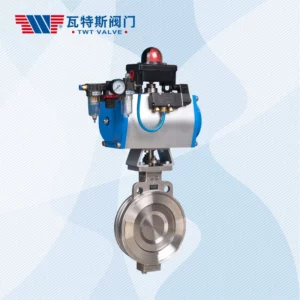Modulating high-performance butterfly valves play a crucial role in providing precise control of fluid flow in industrial processes. These valves are designed to offer accurate and efficient modulation of flow rates, contributing to improved process control and overall system performance.
Here are several ways in which modulating high-performance butterfly valves contribute to precise control in industrial processes:
- Linear Flow Characteristics:
- High-performance butterfly valves are engineered to exhibit linear flow characteristics, meaning that the relationship between the valve position and the flow rate is relatively constant. This linearity facilitates more predictable and precise control, allowing for accurate adjustments to meet specific process requirements.
- Wide Range of Control:
- Modulating butterfly valves are capable of handling a wide range of flow rates. This versatility enables them to effectively modulate the flow of fluids in various industrial applications, adapting to changing process conditions and demands.
- Positioning Accuracy:
- These valves are equipped with precise actuators and control systems that enable accurate positioning of the valve disc. This high level of positioning accuracy ensures that the valve can be finely adjusted to achieve the desired flow rate, minimizing overshooting or undershooting of setpoints.
- Fast Response Time:
- High-performance butterfly valves, particularly those with advanced actuation systems, offer fast response times. The quick opening and closing capabilities of these valves allow for rapid adjustments to changing process conditions, contributing to dynamic and responsive control.
- Stable Control at Partial Loads:
- Modulating butterfly valves maintain stable control even at partial loads. This is especially important in industrial processes where varying demand levels are common. The valves can accurately modulate flow rates, high performance butterfly valves preventing unnecessary energy consumption during periods of lower demand.
- Low Pressure Drop:
- High-performance butterfly valves are designed to minimize pressure drop across the valve. This characteristic ensures that the system operates efficiently, with less energy loss, and allows for precise control without sacrificing overall system performance.
- Tight Shutoff Capability:
- These valves are capable of providing tight shutoff when fully closed. This feature is essential for applications where preventing leakage or backflow is critical to maintain process integrity and safety.
- Adaptability to Different Media:
- High-performance butterfly valves can handle a variety of media, including liquids, gases, and slurries. Their adaptability to different types of fluids makes them suitable for a wide range of industrial processes.
- Integration with Control Systems:
- Modulating butterfly valves can be seamlessly integrated into industrial control systems. This integration allows for centralized control, monitoring, and automation, enhancing the precision of fluid flow control within the overall industrial process.
- Durability and Reliability:
- High-performance butterfly valves are constructed from robust materials, ensuring durability and reliability in challenging industrial environments. This reliability is essential for maintaining precise control over extended periods of operation.
In summary, modulating high-performance butterfly valves contribute to precise control of fluid flow in industrial processes through their linear flow characteristics, wide control range, accurate positioning, fast response times, and adaptability to different media. These features make them valuable components in applications where precise control is essential for optimal process performance.
